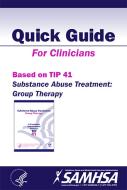This guide helps counselors improve their skills in leading group therapy sessions for substance use treatment. The guide discusses types of group therapy, confidentiality, client placement, group development, stages of treatment, how-to tips, training, and supervision.
Dashboard: Filter Bricks
Main page content

This manual describes brief intervention and therapy techniques for the treatment of alcohol and drug misuse.

These guidelines are for clinicians who lead group therapy sessions for substance use disorder treatment. It describes types of group therapy, and advantages of group therapy. The guide also provides client placement criteria, and techniques for group development and leadership.

This manual is designed as a seven-module training guide for group therapy in substance use disorder treatment. The modules assist counselors and other clinical staff in understanding and implementing evidence-based practices as described in TIP 41. Access training modules with trainers’ notes, talking points, and slides.

This manual introduces counselors and therapists to brief intervention and therapy for mental illness, substance use disorders, or both. It presents practical methods and case scenarios for implementing shorter forms of treatment for a range of populations and issues.

This resource gives a brief overview on conducting a suicide assessment using a five-step evaluation and triage plan. The five-step plan involves identifying risk factors and protective factors, conducting a suicide inquiry, determining risk level and interventions, and documenting a treatment plan. Suicide Safe mobile app based on the SAFE-T is available on the app stores. Download SAMHSA's Suicide Safe mobile app on your mobile device.

This manual helps mental health professionals build an emergency preparedness program in response to mass violence and terrorism. It includes background information, key concepts in mental health intervention, and guidance for setting up a training course.


